Add this eBook to your basket to receive access to all 227 records. Our indexes include entries for the spelling ivory. In the period you have requested, we have the following 227 records (displaying 211 to 220): These sample scans are from the original record. You will get scans of the full pages or articles where the surname you searched for has been found. Your web browser may prevent the sample windows from opening; in this case please change your browser settings to allow pop-up windows from this site. Civil Servants and Office Holders
(1913)
The Imperial Calendar gives lists of officials and office-holders throughout England, Wales, Scotland and Ireland
| Sample scan, click to enlarge
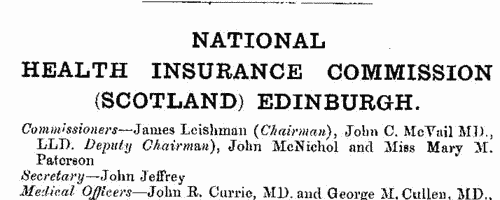
| Killed in the Great War: The King's (Liverpool Regiment)
(1916)
Lists of names of soldiers wounded, died of wounds, died, missing presumed dead, and taken prisoner by the enemy, were issued to the British national press under the title Roll of Honour. Each man is identified by surname, initials and number. The regimental returns from which the daily Roll was compiled were made up over the previous week or weeks. Each regimental return may be partial, covering only part of the alphabet. The lists are provisional, in that a man reported wounded one day may appear as died of wounds later; a missing presumed dead may later be reported as having been found, or as having died; the lists of prisoners of war were provided by the enemy and will relate to captures weeks earlier. However, these rolls are the most comprehensive single source of names of British and allied combatants meeting with misfortune in the Great War. This is the roll published 4 August 1916. | Sample scan, click to enlarge

| Meritorious Service Medal
(1918)
King George V on 17 June 1918 approved of the award of the Meritorious Service Medal to these Warrant Officers, Non-commissioned Officers and Men, in recognition of valuable services rendered with the Forces in France during the Great War. | Sample scan, click to enlarge
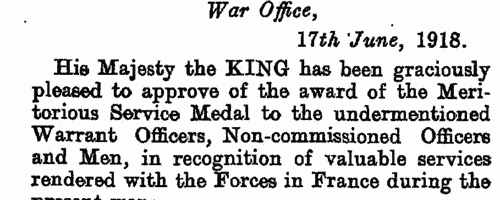
| Scientific Poultry Breeders
(1932)
The Scientific Poultry Breeders Association was by far the largest poultry society in Great Britain, with 16,109 members for the year 1930-1931. This seventeenth annual register, for the year 1932, lists members alphabetically by surname and initials, with addresses. P. F. stands for Poultry Farm. | Sample scan, click to enlarge

| Officers of the British Army and of the Indian Army
(1934)
The Half-Yearly Army List, issued By Authority, 30 June 1934, lists all officers in active service at that date, and this list was evidence of the status and rank of the officers contained in it. The entries are set out as a gradation list, by rank, from field-marshals to lieutenants, and within each rank in order of seniority at that rank. Each officer's name (surname first, in capitals, then christian name and present rank (with date of achieving that rank) and regiment &c. are given, for convenience, in bold type, with any national decorations in italics after the name. Each entry also gives date of birth, number of days service in the ranks, dates of service in each rank of officer, particular offices and postings (with dates) and, where appropriate, a summary of war service, and medals. For all but the oldest of the officers then serving, the war service details are for the Great War (1914-1921), and campaigns in Iraq, Waziristan, and the North West Frontier of India. War services are not given in this edition for Indian Army officers, except in that their entries are preceded by a crossed swords symbol where they have seen war service in a theatre of war overseas. After the gradation list of officers, there is a section for the Royal Malta Artillery; and then (pages 1152 to 1185) warrant officers - staff or garrison serjeant-majors, educational serjeant-majors, serjeant-major (physical training and educational) instructors, regimental serjeant-majors (and corporal-majors, farrier-serjeant majors, master gunners, assistant instructors in gunnery, experimental serjeant-majors, artillery clerks, farrier-serjeant-majors, artificer serjeant-majors, clerks of works, mechanist, superintending clerks, draughtsmen, 1st class staff serjeant-majors, transport, supply, conductors, sub-conductors, armourers, armament artificers, headmasters, schoolmasters, marine gunners, and bandmasters. The section for the Royal Army Chaplains' Department lists all chaplains (1st to 3rd class); and that for Queen Alexandra's Imperial Military Nursing Service has all matrons, sisters and staff nurses. The lists of nurses do not give date of birth: all are unmarried. The book concludes with the Yeomen of the Guard, the Honourable Company of Gentlemen-at-Arms, and the King's Body Guard for Scotland, in each case giving name (surname and initials, not christian names), honours, name of late regiment, and date of appointment.
| Sample scan, click to enlarge
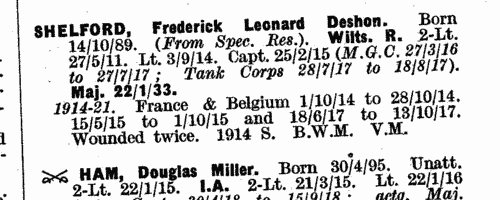
| British Civil Servants
(1935)
The British Imperial Calendar lists civil servants in Britain, arranged according to the organizational structure of the state, and shows their qualifications and salaries. | Sample scan, click to enlarge
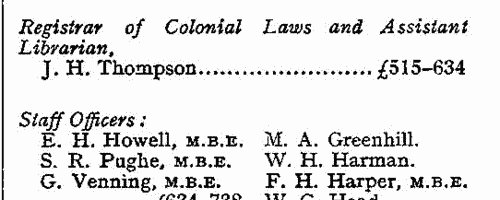
| Members of Cambridge University
(1935)
The Cambridge University Calendar for 1935-1936 includes this list of all living members of the university, i. e. not only undergraduates and members of staff, but also all surviving graduates from earlier generations. The names are arranged alphabetically by surname, then by college in order of foundation, and under the particular colleges by order of seniority of the B. A. degree. Surnames are given, initials, name of college, and then the years of graduating B. A. and M. A. Where a change of name had occurred since matriculation, the original name is inserted in brackets. For undergraduates the term of matriculation is given in square brackets with an M for Michaelmas, L for Lent or E for Easter. An asterisk before a surname indicates a member of the Senate. Names which appeared on the roll of the Regent House promulgated in November 1934 are marked with a dagger. Further degrees, such as PHD, MB, BCHIR, MD, &c. are listed in smaller capitals with the year conferred. | Sample scan, click to enlarge
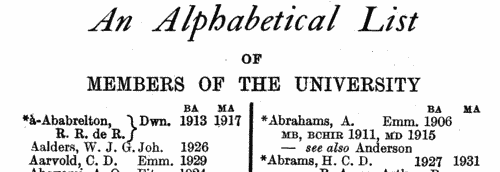
| London Telephone Subscribers
(1939)
The London telephone directory lists subscribers alphabetically by surname and then by christian name or initials, with their postal address and telephone number. This is the L to Z directory issued in May 1939, but also contains some names from earlier in the alphabet, for instance in the separate section for midwives. The London telephone districts comprised not only the city centre, but also the very extensive suburbs in the Home Counties (Essex, Kent, Surrey and Middlesex). | Sample scan, click to enlarge

| British Dentists
(1950)
The Dentists Register is the official register of British dental practitioners. For each dentist the original certificate number is given; name (surname first, in bold; in the case of married women, maiden name is also usually given); address (in italics); date of registration; and the qualification entitling registration, with any additional qualifications, with year and place of qualification. Many of the older dentists, already practising by 1921, were qualified by virtue of the Dentists Act of that year. | Sample scan, click to enlarge

| Imperial Service Medal: Home Civil Service
(1950)
The Central Chancery of the Orders of Knighthood at St James's Palace announced the award by king George VI on 21 November 1950 of the Imperial Service Medal to members of the Home Civil Service; of the New South Wales and Queensland Fire Departments; and of the Colonial Service. The names are arranged alphabetically by surname (in capitals) and christian names, with office or rank in the service. | Sample scan, click to enlarge
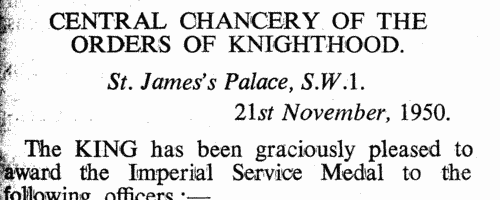
|
Research your ancestry, family history, genealogy and one-name study by direct access to original records and archives indexed by surname.
|











